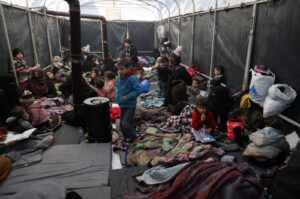After two earthquakes with their epicenters in southeast Turkiye left Syria’s opposition-held regions in ruins, the Assad administration eventually gave the go-ahead for humanitarian relief delivery there.
The U.N., Syrian Red Crescent, and worldwide Red Cross would work together to deliver aid to those in need, Syrian official media announced on Friday.
Lattakia, Hama, Aleppo, and Idlib, the areas most severely impacted by Monday’s catastrophic earthquake, had also been named disaster zones by the regime, and a fund would be established to aid in their rehabilitation.
To serve the millions of people affected, the UN stated Friday that it was quickly using all the aid supplies it had in Syria before to the deadly earthquake.
At least 22,000 people have died in Turkey and Syria as a result of Monday’s earthquake, according to U.N. agencies, and the relief efforts will go well beyond the initial, life-saving search and rescue phase.
Currently, the only route by which U.N. aid can bypass regime-controlled areas and reach civilians in war-torn Syria is through the Bab al-Hawa crossing from Turkiye. International sanctions are currently in place on the Syrian government.
As it seeks to restock its stores, the U.N. has demanded that politics be eliminated from the disaster response.
Catharina Boehme from the World Health Organization (WHO) headquarters team stated, “We cannot accept any obstacles in this situation.
“All individuals in need must have access to aid and medical attention. Whether we can make this possible will determine how effective the UN is as a whole “She spoke at a Geneva briefing.
The WFP has pre-positioned stores of food in northwest Syria that is ready to eat for 125,000 people and enough family rations that need to be cooked for 1.4 million people for one month, according to Corinne Fleischer, the WFP’s Middle East regional director.
The remainder is being distributed, and ready-to-eat food has already reached 30,000 people.
Fleischer stated via videolink from Cairo, “We are running out of inventories and we need access to bring more products in.”
“Both natural calamities and humanitarian relief have no regard for national boundaries. We need to be able to restock in northwest Syria.”
Before the earthquake, the UNHCR, the U.N.’s refugee agency, had 20,000 tents and 30,000 so-called basic relief items—mattresses, blankets, cooking sets, plastic sheeting, jerry cans, and sleeping mats—pre-positioned in Syria.
The UNHCR representative in the nation, Sivanka Dhanapala, stated, “We have been giving them since Day One.”
He said via videolink, “A lot of material is being given out and needs to be refilled as soon as possible.”
The agency’s immediate efforts are concentrated on providing shelter and relief supplies as well as making sure that communal centers taking in displaced people have suitable facilities.
Dhanapala added, “We’re also looking at what happens in four, eight, and 12 weeks.”
According to him, “we look at supporting livelihoods and basic services in affected communities when we look at eight to 12 weeks,” including attempting to make small repairs in damaged housing.
Longer term, he continued, “we would look at debris disposal” and making an effort to mobilize engineers.





